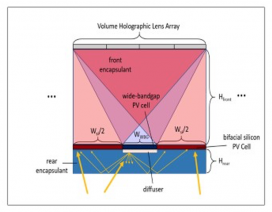Bifacial Spectrum-Splitting PV Module Designs Achieve Increased Energy Gains from Solar Power
Researchers at Quantum Energy and Sustainable Solar Technologies (QESST), a National Science Foundation (NSF)-sponsored Engineering Research Center (ERC) headquartered at Arizona State University (ASU), have designed a bifacial spectrum-splitting (BFSS) photovoltaics (PV) module that increases the energy gains possible from solar power. The invention leverages volume holographic lenses to efficiently divide the solar spectrum between cells.
BFSS PV modules afford higher efficiency while extending options for converting both diffuse sunlight as well as rear-side irradiance, thereby making solar power installations more feasible and effective under a greater variety of conditions. With one-axis tracking, the BFSS configuration can increase energy yield by up to 45% over conventional silicon modules, including conventional monofacial silicon, bifacial silicon, and monofacial spectrum-splitting modules. By pairing the BFSS module with additional solutions, designers can also balance energy yield with cost and size considerations to better meet constraints such as concentration ratio and aspect ratio.
QESST’s study resulted in two designs for BFSS cells – a gallium arsenide (GaAs) / bifacial silicon combination and a magnesium cadmium telluride (MgCdTe) / bifacial silicon combination. Both designs were shown to achieve higher solar efficiency. The BFSS modules use a volume holographic lens array to divide the solar spectrum into spectral bands optimized for conversion by wide-bandgap and bifacial silicon solar cells.
The research was presented at SPIE Optics and Photonics 2019 and published as B. Chrysler et al., “Spectrum-splitting Photovoltaic System using Bifacial Cells for High Energy Yield,” SPIE, 11121 (2019). Design details have also been filed as UA Invention Disclosure UA19-129. QESST is jointly supported by NSF and the U.S. Department of Energy (DOE).



